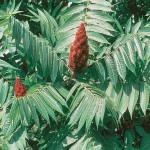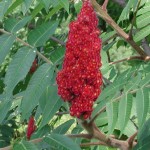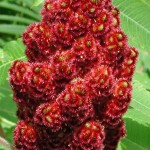
Although a number of hikers opted out due to the forecast for snow, a few hikers braved the weather forecast and went in search of animal tracks and signs at Detweiler Park in Dauphin County. Snow was still on the ground which aided our goal of finding various animal tracks.
A discussion on track identification and a group activity on movement patterns was provided at the onset. Tracking guides and informative handouts were also provided prior to starting our venture into the woods. Armed with our knowledge and tracking guides we hit the trails!
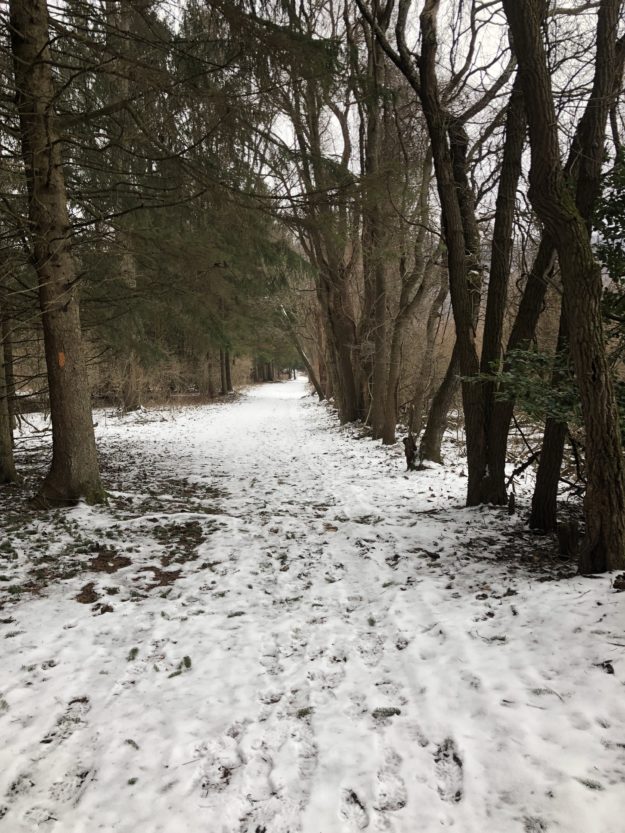
The start of the hike. 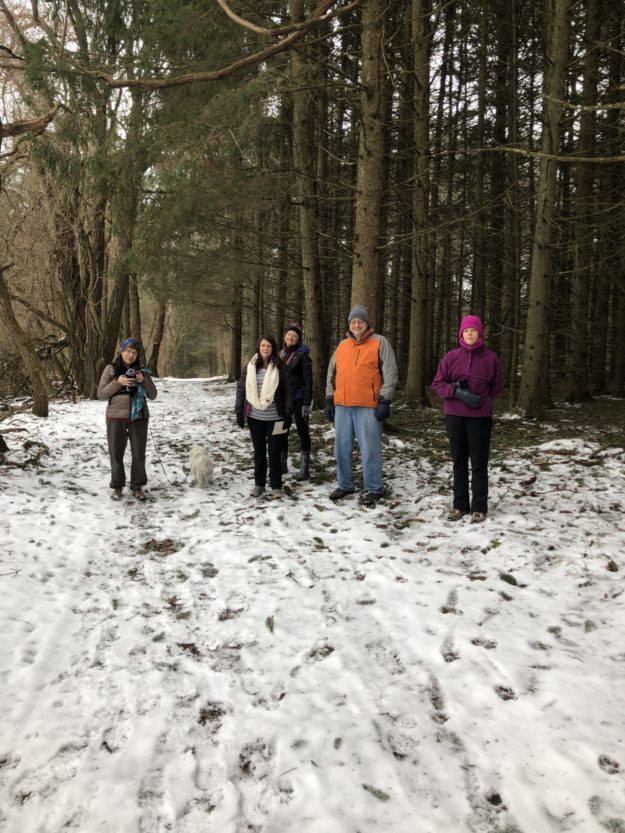
Quick stop for a picture. 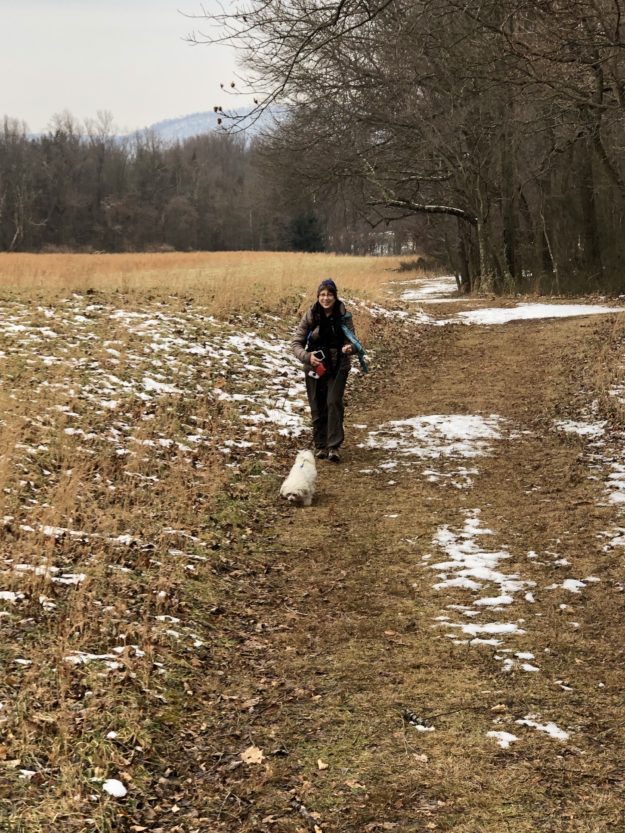
The start of a climb, 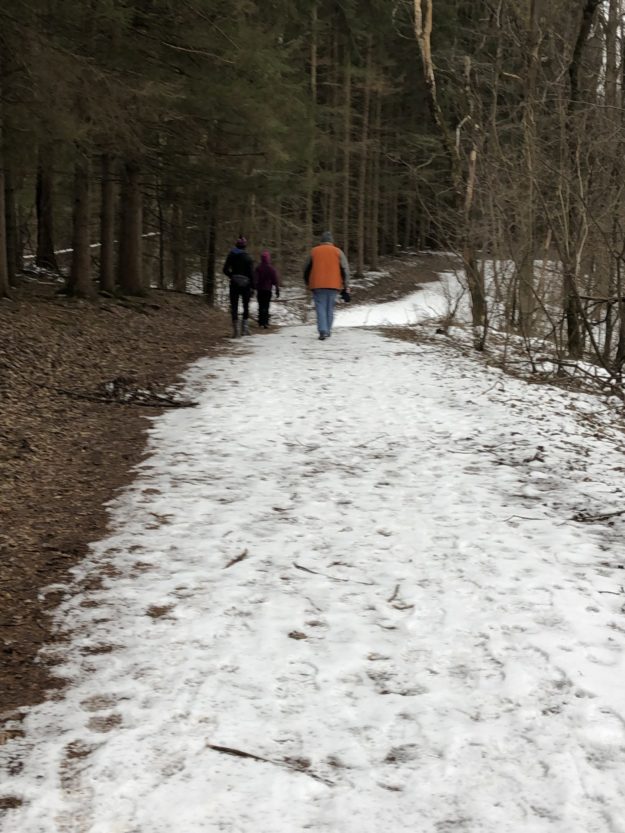
Heading back 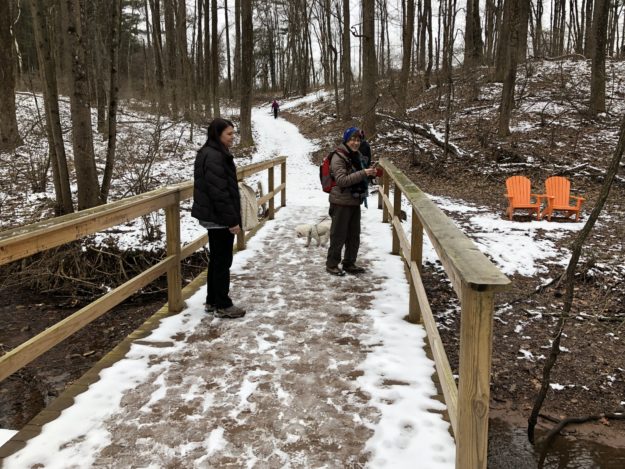
Pictures from the bridge. 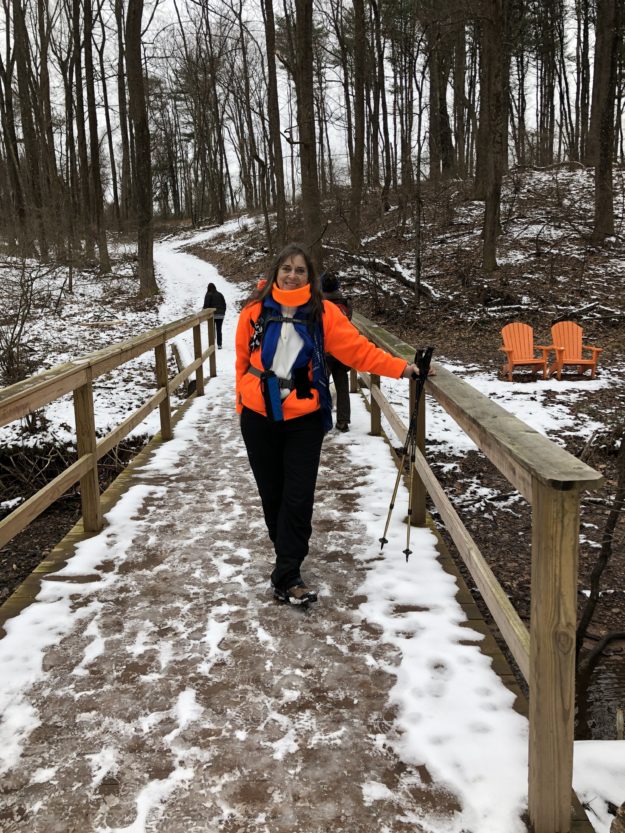
Almost at the end. 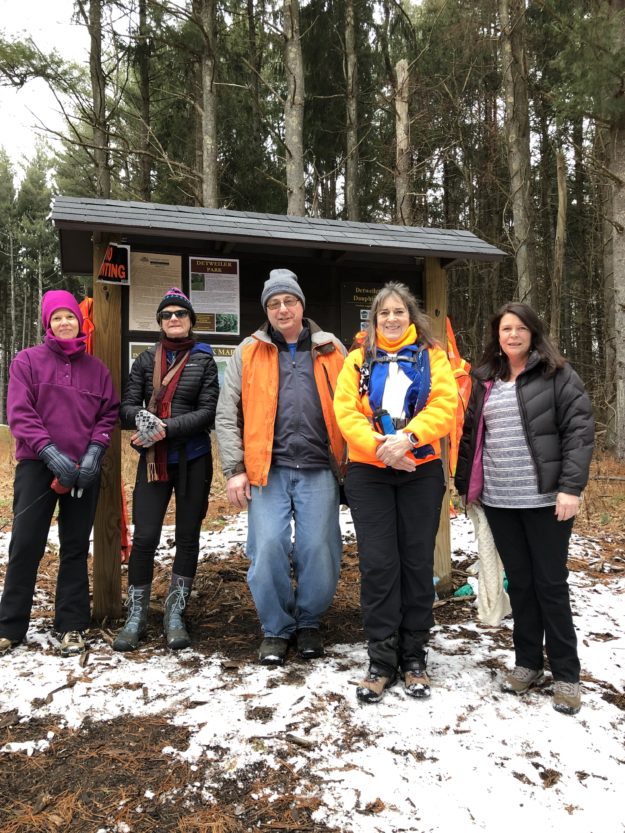
We are finished! 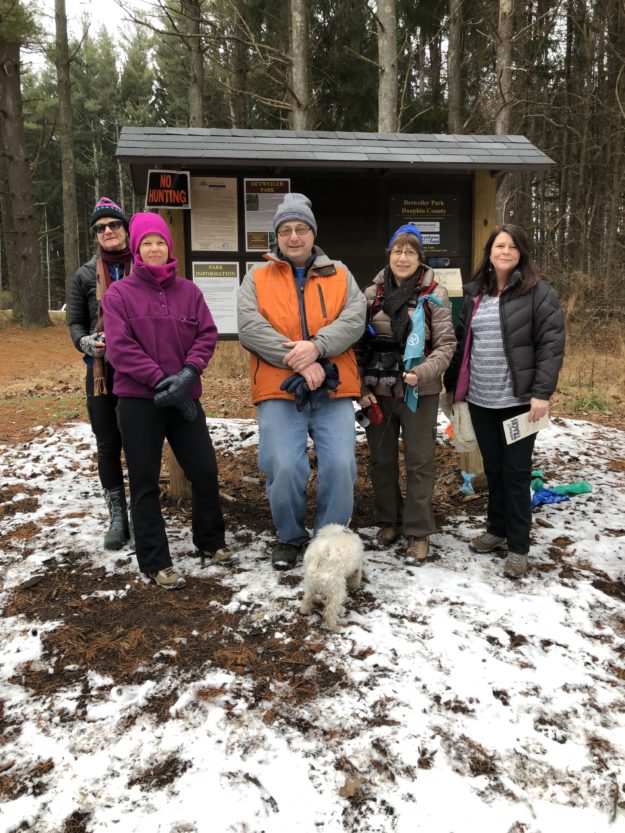
Participants at hike’s end.
Tracking and looking for animal signs is a great year round way to exercise and investigate your surroundings. A serious tracker usually follows some basic steps, some of which are listed below:
- Determine the movement pattern
- Notice the distance from one side print to another (width of the animal, the straddle)
- Measure the size of a print (http://www.pgc.state.pa.us available track measurement guide, Tracks In Your Backyard)
- Notice how many toes are present
- Check for claw marks
- Check surroundings for signs: what was the animal doing,where was it going, are there food remnants, trails, fur or feathers, scats and if so what are the contents of the scats? etc.
There are four basic movement patterns for mammals in the tracking world. Unfortunately, terminology can vary.
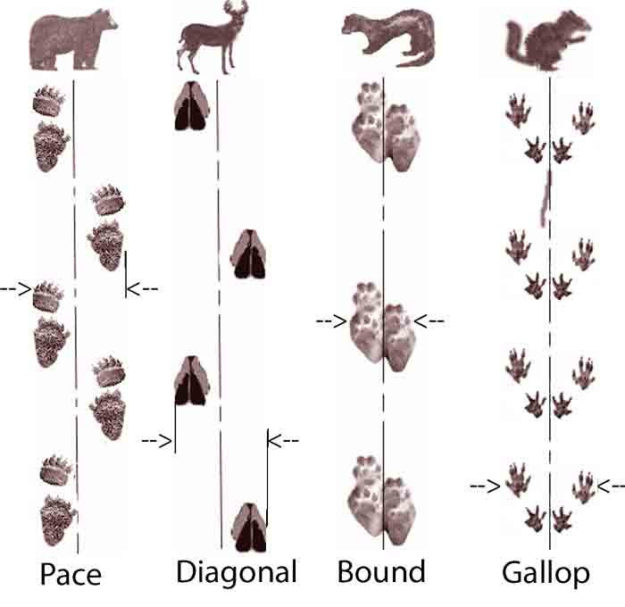
The Waddler is often referred to as a Pacer, while the Walker/Trotter is often called the Diagonal Pattern or Straight Walker. Then there are the Bounders and Gallop pattern which is also labeled a Hopper. For the sake of clarity Waddler, Walker/Trotter, Bounder and Hopper terms will be used in this article.
Waddlers walk slowly on flat feet and have heavy bodies and short legs. They move both feet on one side of the body one at a time, then shift their weight to move each foot on the other side. Tracks show both the smaller front foot and the larger hind foot with the hind foot often overstepping the front foot. Common waddlers are bears, beavers, porcupines, raccoons, muskrats, and woodchucks. Skunks are often labeled waddlers but are not true waddlers, since they also amble with a looping stroll as well as hop for short distances.
Walker/Trotters have a body length from shoulder to rump equal to the length of their legs. They walk smoothly on their toes or hooves by moving the front foot on one side of the body and then the back foot on the other side; repeating this pattern starting with the front foot on the other side. Members of this group include the cat family, dog family, and hoofed animals. They also can trot which involves moving the right front foot and left rear foot simultaneously and then switching to the left front foot and the right rear foot resulting in a straight line track pattern and a brief moment when air born. Walkers/Trotters often leave only their hind tracks when moving, since they place their back foot directly on the track of the front foot. This pattern is called a direct register. When both the front and back tracks are visible it is referred to as an indirect register. Predators are known for walking with a direct register.
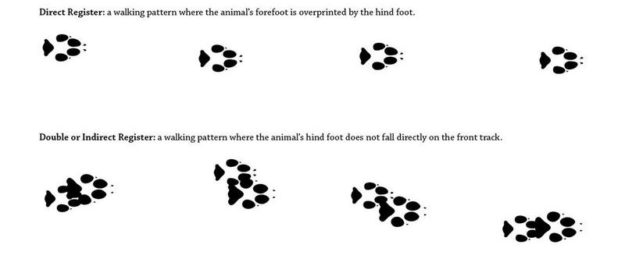
Bounders have short legs and long bodies and move like an accordion. Crouching and jumping off their hind feet they become air born. Fully stretching their bodies, they land one front foot prior to the other,for a brief moment, before the back two feet take the place of the front feet. Track patterns of bounders usually show only hind prints. Occasionally, there are three tracks when one of the hind feet does not register directly on the front track. All mammals of this group are members of the weasel family which includes: the least weasel, shorttail weasel, longtail weasel, mink, marten fisher, and otter.
Hoppers have large hind feet which are much longer then the front feet. By pushing off with the hind feet, they land on the front feet and swing the back feet ahead of the front, resulting in four tracks with the hind prints ahead of the front prints. This group includes the rodent family such as: mice, shrews, voles, moles, squirrels, and chipmunks. The lagomorph (rabbits) are also considered hoppers.
Taking measurements can also help one identify what creature created the print. The width from one side print to another side print (the straddle) and the actual size of a print helps one narrow down the possibilities. For instance, if you determine a track is that of the dog family it helps to know that coyotes are larger than red foxes, which are bigger than gray foxes, Dogs, however, come in all sizes and one would have to use other clues to determine which member of the dog family made the print. Did you find it in a park or in the middle of the woods?
A track itself can speak volumes. Tracks from the cat family do not have claw marks, while the dog family tracks do. Members of the cat and dog families have four toes. Most other animals have five toes except for members of the rodent family who have five toes on the hind feet and four on the front. Bird tracks usually show four toes, three facing forward and one back. Rabbit and squirrel tracks can look similar since they are both hoppers, however, the front feet tracks of a squirrel will be side by side, and the front feet tracks of the rabbit will be diagonal. Raccoon tracks look like human hands. Opossums’ hind feet have opposing thumbs evident in the print. Hoofed animals, such as deer and moose, have heart shaped tracks that may or may not have two circular impressions toward the back of the track. These impressions are made by dew claws. When dew claw impressions are present it may indicate a big heavy animal, usually a buck. Animal tracks may also include tail impressions; often evident in the tracks of shrews, mice, possums, and muskrats.
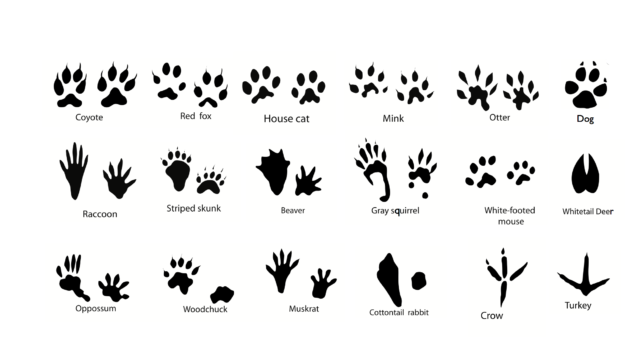
Below are some tracks we saw on our hike:
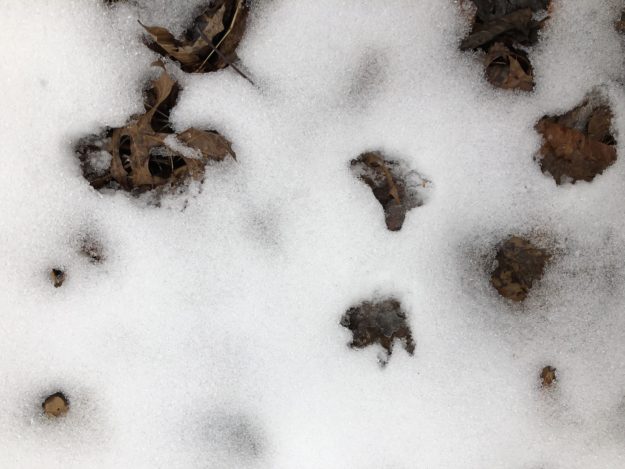
Opossum – notice the opposing thumb. 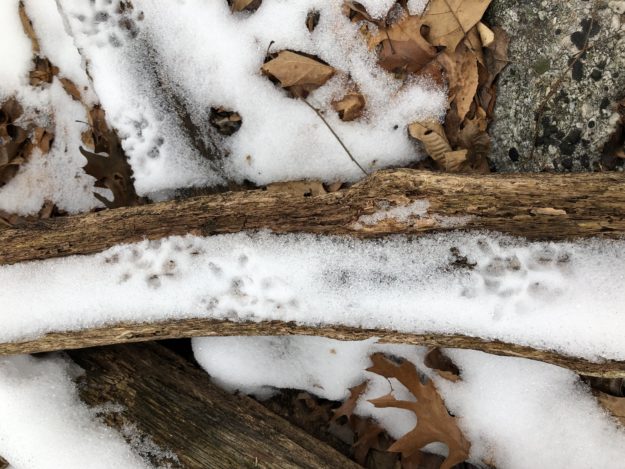
More Opossum prints 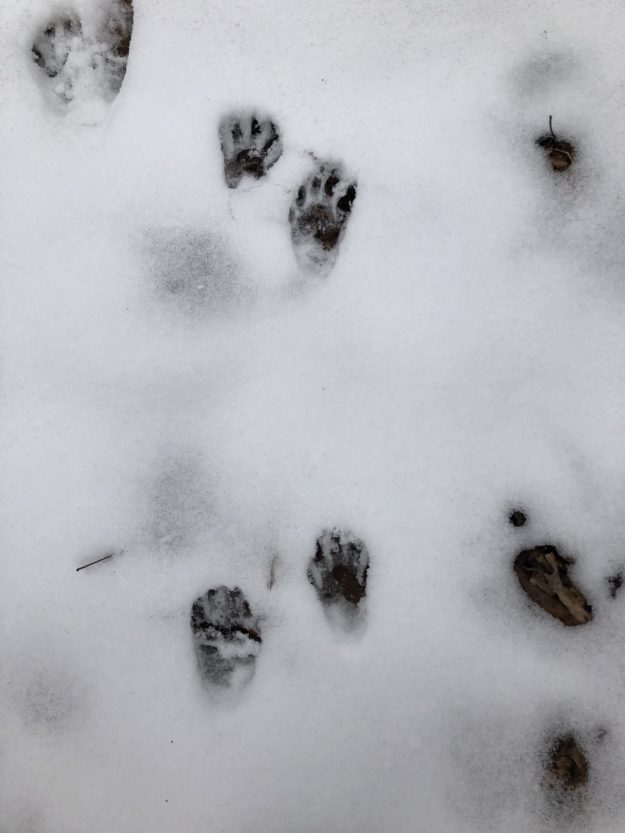
Raccoon tracks 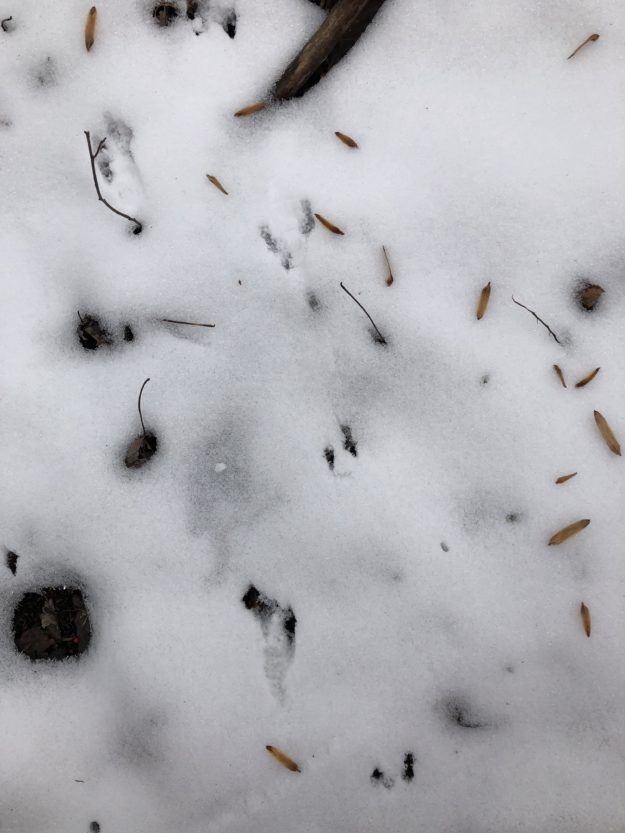
Small bird tracks
There are many clues that can assist you in the identification of animal tracks, some of which are listed below:
- Antler rub – smaller trees where bark as been rubbed off by buck antlers
- Antler Shed – deer antlers on the ground shortly after rutting season, hard to find since quickly eaten for high content of protein, minerals and calcium
- Bed – were an animal rests regularly, look at size, shape, construction,
- Browse – when an animal or groups of animals eat a particular plant or tree, look at type of food, teeth marks, location of marks, (twigs eaten by rabbits will show a clear cut)
- Claw marks – marks of an animals claws on trees or on the ground
- Debarking – removal of bark in small or large patches from trees and logs to gain access to inner bark layers, (often done by porcupines high in trees and at the bottom of trees by rabbits)
- Dig – when an animal digs in snow, leaves, underbrush, or the ground in search for food
- Food remnants – remainders of a meal, what was the animal eating, what creature eats this type of food
- Hair/Quills – often an animal’s hair or quills can be found on trails, near dens, and in scat
- Hole/Den – a dwelling built into the earth, look at size, shape, and construction, usually dug by woodchucks, fox, porcupines, all weasels, and small rodents. Note: Rabbits do not dig holes!
- Incisor Scrape – upward tears made by members of the deer family when removing bark from trees and biting off limbs, (twigs eaten by deer have a clear cut on one side of the end and be shredded on the other)
- Kill Sights – where a predator has killed an animal, look at how the animal was killed, eaten, etc.
- Lay – where an animal slept or rested once, look at size, shape, and construction
- Lodge – dwelling constructed of branches, small trees, and mud, ex. a beaver,
- Midden – conifer wings left in a pile after seeds are eaten by a squirrel
(mice scatter the wings around when eating seeds out of a pine cone) - Nest – a swelling built of leaves, brush, and small branches, usually in or on a tree, ex birds and squirrels, Note: hummingbirds build their nests out of spider webbing and lichen
- Run – the path of one type or multiple types of animals used over and over again, look at tracks, size of path, and where it leads
- Scats – animal feces, look at shape, size, age, and what is in it – bones, hair, bark, seeds, bugs, etc.
- Scrape – process of scraping the ground and scenting it with urine The deer family does this during rutting season.
- Track – the actual paw/hoof/foot print
- Trail – where an animal has walked once
Now it is time to take this knowledge to the fields and forests. Have fun.
:




